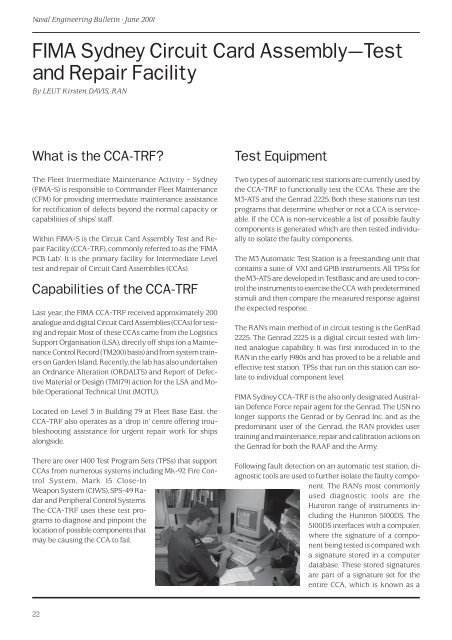Engineering - Royal Australian Navy
Engineering - Royal Australian Navy
Engineering - Royal Australian Navy
Create successful ePaper yourself
Turn your PDF publications into a flip-book with our unique Google optimized e-Paper software.
Naval <strong>Engineering</strong> Bulletin • June 2001<br />
FIMA Sydney Circuit Card Assembly—Test<br />
and Repair Facility<br />
By LEUT Kirsten DAVIS, RAN<br />
What is the CCA-TRF?<br />
Test Equipment<br />
The Fleet Intermediate Maintenance Activity - Sydney<br />
(FIMA-S) is responsible to Commander Fleet Maintenance<br />
(CFM) for providing intermediate maintenance assistance<br />
for rectification of defects beyond the normal capacity or<br />
capabilities of ships’ staff.<br />
Within FIMA-S is the Circuit Card Assembly Test and Repair<br />
Facility (CCA-TRF), commonly referred to as the ‘FIMA<br />
PCB Lab’. It is the primary facility for Intermediate Level<br />
test and repair of Circuit Card Assemblies (CCAs).<br />
Capabilities of the CCA-TRF<br />
Last year, the FIMA CCA-TRF received approximately 200<br />
analogue and digital Circuit Card Assemblies (CCAs) for testing<br />
and repair. Most of these CCAs came from the Logistics<br />
Support Organisation (LSA), directly off ships (on a Maintenance<br />
Control Record (TM200) basis) and from system trainers<br />
on Garden Island. Recently, the lab has also undertaken<br />
an Ordnance Alteration (ORDALTS) and Report of Defective<br />
Material or Design (TM179) action for the LSA and Mobile<br />
Operational Technical Unit (MOTU).<br />
Located on Level 3 in Building 79 at Fleet Base East, the<br />
CCA-TRF also operates as a ‘drop in’ centre offering troubleshooting<br />
assistance for urgent repair work for ships<br />
alongside.<br />
There are over 1400 Test Program Sets (TPSs) that support<br />
CCAs from numerous systems including Mk-92 Fire Control<br />
System, Mark 15 Close-In<br />
Weapon System (CIWS), SPS-49 Radar<br />
and Peripheral Control Systems.<br />
The CCA-TRF uses these test programs<br />
to diagnose and pinpoint the<br />
location of possible components that<br />
may be causing the CCA to fail.<br />
Two types of automatic test stations are currently used by<br />
the CCA-TRF to functionally test the CCAs. These are the<br />
M3-ATS and the Genrad 2225. Both these stations run test<br />
programs that determine whether or not a CCA is serviceable.<br />
If the CCA is non-serviceable a list of possible faulty<br />
components is generated which are then tested individually<br />
to isolate the faulty components.<br />
The M3 Automatic Test Station is a freestanding unit that<br />
contains a suite of VXI and GPIB instruments. All TPSs for<br />
the M3-ATS are developed in TestBasic and are used to control<br />
the instruments to exercise the CCA with predetermined<br />
stimuli and then compare the measured response against<br />
the expected response.<br />
The RAN’s main method of in circuit testing is the GenRad<br />
2225. The Genrad 2225 is a digital circuit tested with limited<br />
analogue capability. It was first introduced in to the<br />
RAN in the early 1980s and has proved to be a reliable and<br />
effective test station. TPSs that run on this station can isolate<br />
to individual component level.<br />
FIMA Sydney CCA-TRF is the also only designated <strong>Australian</strong><br />
Defence Force repair agent for the Genrad. The USN no<br />
longer supports the Genrad or by Genrad Inc. and as the<br />
predominant user of the Genrad, the RAN provides user<br />
training and maintenance, repair and calibration actions on<br />
the Genrad for both the RAAF and the Army.<br />
Following fault detection on an automatic test station, diagnostic<br />
tools are used to further isolate the faulty component.<br />
The RAN’s most commonly<br />
used diagnostic tools are the<br />
Huntron range of instruments including<br />
the Huntron 5100DS. The<br />
5100DS interfaces with a computer,<br />
where the signature of a component<br />
being tested is compared with<br />
a signature stored in a computer<br />
database. These stored signatures<br />
are part of a signature set for the<br />
entire CCA, which is known as a<br />
22
















